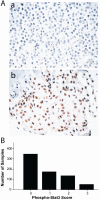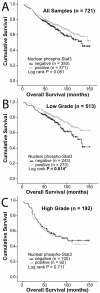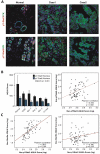Signal transducer and activator of transcription-3 and breast cancer prognosis
- PMID: 21776434
- PMCID: PMC3138712
Signal transducer and activator of transcription-3 and breast cancer prognosis
Abstract
Signal transducer and activator of transcription-3 (Stat3) is frequently activated in breast cancer and multiple lines of evidence suggest that Stat3 promotes tumor progression. However, the prognostic value of Stat3 in human breast cancer remains controversial and associations range from favorable to unfavorable based on four outcome studies of 62, 102, 255 and 517 patients. Cellular Stat3 protein expression was measured in three studies whereas nuclear localized, tyrosine phosphorylated Stat3 (Nuc-pYStat3) was used as the readout in only one study. We therefore retrospectively analyzed the prognostic value of Nuc-pYStat3 in a larger material of 721 breast cancer specimens. Overall, patients whose tumors were positive for Nuc-pYStat3 tended to have improved survival, but the trend did not reach statistical significance (P=0.08). When specimens were stratified by tumor grade, patients with low grade but not high grade tumors that were positive for Nuc-pYStat3 had significantly prolonged overall survival in univariate analysis (P=0.014) but not in multivariate analyses. Unexpectedly, quantitative immunofluoresence detection revealed highest levels of Nuc-pYStat3 in normal breast epithelia and gradual loss of Nuc-pYStat3 during progression from DCIS, invasive ductal carcinoma, and lymph node metastases. Levels of Nuc-pYStat3 correlated positively with levels of Nuc-pYStat5, a favorable prognostic marker, in invasive ductal carcinomas. Furthermore, NucpYStat3 levels correlated strongly with protein levels of nuclear localized Stat5a (r=0.633, P<0.001) but not Stat5b. Our data does not support the notion that Nuc-pYStat3 is an independent marker of prognosis in breast cancer, although future studies may reveal prognostic utility within molecularly characterized subtypes of breast cancer.
Keywords: Stat3; biomarker; breast cancer; immunohistochemistry; prognosis; survival.
Figures



Similar articles
-
Loss of nuclear localized and tyrosine phosphorylated Stat5 in breast cancer predicts poor clinical outcome and increased risk of antiestrogen therapy failure.J Clin Oncol. 2011 Jun 20;29(18):2448-58. doi: 10.1200/JCO.2010.30.3552. Epub 2011 May 16. J Clin Oncol. 2011. PMID: 21576635 Free PMC article.
-
Tissue microarray-based study of patients with lymph node-positive breast cancer shows tyrosine phosphorylation of signal transducer and activator of transcription 3 (tyrosine705-STAT3) is a marker of good prognosis.Clin Transl Oncol. 2012 Mar;14(3):232-6. doi: 10.1007/s12094-012-0789-z. Clin Transl Oncol. 2012. PMID: 22374428
-
Low levels of Stat5a protein in breast cancer are associated with tumor progression and unfavorable clinical outcomes.Breast Cancer Res. 2012 Oct 4;14(5):R130. doi: 10.1186/bcr3328. Breast Cancer Res. 2012. PMID: 23036105 Free PMC article.
-
Quantitative histopathology in ductal carcinoma of the breast. Prognostic value of mean nuclear size and mitotic counts.Cancer. 1995 Apr 15;75(8):2114-22. doi: 10.1002/1097-0142(19950415)75:8<2114::aid-cncr2820750814>3.0.co;2-w. Cancer. 1995. PMID: 7697602
-
Signal transducer and activator of transcription 5a/b: biomarker and therapeutic target in prostate and breast cancer.Int J Biochem Cell Biol. 2011 Oct;43(10):1417-21. doi: 10.1016/j.biocel.2011.06.007. Epub 2011 Jun 17. Int J Biochem Cell Biol. 2011. PMID: 21704724 Free PMC article. Review.
Cited by
-
The relationship between total and phosphorylated STAT1 and STAT3 tumour cell expression, components of tumour microenvironment and survival in patients with invasive ductal breast cancer.Oncotarget. 2016 Nov 22;7(47):77607-77621. doi: 10.18632/oncotarget.12730. Oncotarget. 2016. PMID: 27769057 Free PMC article.
-
Stat3 Tyrosine 705 and Serine 727 Phosphorylation Associate With Clinicopathological Characteristics and Distinct Tumor Cell Phenotypes in Triple-Negative Breast Cancer.Pathol Oncol Res. 2022 Aug 9;28:1610592. doi: 10.3389/pore.2022.1610592. eCollection 2022. Pathol Oncol Res. 2022. PMID: 36017196 Free PMC article.
-
Viscum album Induces Apoptosis by Regulating STAT3 Signaling Pathway in Breast Cancer Cells.Int J Mol Sci. 2023 Jul 26;24(15):11988. doi: 10.3390/ijms241511988. Int J Mol Sci. 2023. PMID: 37569363 Free PMC article.
-
Central Roles of STAT3-Mediated Signals in Onset and Development of Cancers: Tumorigenesis and Immunosurveillance.Cells. 2022 Aug 22;11(16):2618. doi: 10.3390/cells11162618. Cells. 2022. PMID: 36010693 Free PMC article. Review.
-
The role of STAT3 activation in modulating the immune microenvironment of GBM.J Neurooncol. 2012 Dec;110(3):359-68. doi: 10.1007/s11060-012-0981-6. Epub 2012 Oct 25. J Neurooncol. 2012. PMID: 23096132 Free PMC article.
References
-
- Zhong Z, Wen Z, Darnell JE., Jr Stat3: a STAT family member activated by tyrosine phosphorylation in response to epidermal growth factor and interleukin-6. Science. 1994;264:95–98. - PubMed
-
- Darnell JE, Jr, Kerr IM, Stark GR. Jak-STAT pathways and transcriptional activation in response to IFNs and other extracellular signaling proteins. Science. 1994;264:1415–1421. - PubMed
-
- Bowman T, Garcia R, Turkson J, Jove R. STATs in oncogenesis. Oncogene. 2000;19:2474–2488. - PubMed
-
- Garcia R, Yu CL, Hudnall A, Catlett R, Nelson KL, Smithgall T, Fujita DJ, Ethier SP, Jove R. Constitutive activation of Stat3 in fibroblasts transformed by diverse oncoproteins and in breast carcinoma cells. Cell Growth Differ. 1997;8:1267–1276. - PubMed
-
- Sartor CI, Dziubinski ML, Yu CL, Jove R, Ethier SP. Role of epidermal growth factor receptor and STAT-3 activation in autonomous proliferation of SUM-102PT human breast cancer cells. Cancer Res. 1997;57:978–987. - PubMed
Grants and funding
LinkOut - more resources
Full Text Sources
Miscellaneous
